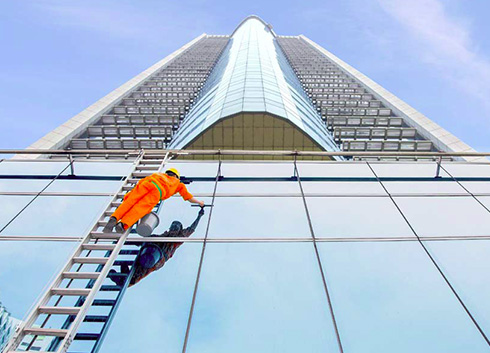
Understanding Safety Standards and Regulations for Traversing Ladder in the Philippines
Maintaining the facades of high-rise buildings presents unique challenges, and ensuring safety during these tasks is paramount. Traversing ladder, such as the SafeLadder system, play a critical role in this process by providing secure and efficient access to elevated areas. However, the effectiveness and safety of these ladders depend heavily on adherence to established safety standards and regulations. This blog explores these crucial standards and regulations, highlighting their importance in safeguarding workers and ensuring compliance with legal requirements in the Philippines.
What is a Traversing Ladder?
A traversing ladder, like the SafeLadder, is an advanced tool designed for maintenance and cleaning tasks on building facades. Unlike traditional ladders, traversing ladder move along a SafeAccess rail system installed on the building’s facade or parapet. This movement allows for precise positioning and enhanced stability, thanks to features like wheels at the base and customizable accessories, such as platforms and footrests. These ladders are indispensable for tasks involving facades up to 12 meters high, ensuring both efficiency and safety.
Importance of Safety Standards for Traversing Ladder
Safety standards are essential in preventing accidents and ensuring worker protection when using traversing ladder. Adherence to these standards not only helps avoid legal issues but also enhances operational effectiveness. By following established guidelines, organizations can minimize risks associated with working at heights and ensure that maintenance tasks are performed safely and efficiently.
Key Safety Standards for Traversing Ladder
EN353/1: Personal Protective Equipment for Fall Protection: The EN353/1 standard outlines requirements for personal fall protection equipment used in conjunction with ladders. It ensures that the equipment is designed to prevent falls and protect workers in high-risk situations. Key features include secure anchoring mechanisms and reliable fall arrest systems that must be incorporated into traversing ladder to meet safety requirements.
EN1808: Standards for Suspended Access Equipment: EN1808 covers the safety criteria for suspended access equipment, including traversing ladder. This standard ensures that the equipment is capable of safely supporting both the load and the worker while providing stability during use. Key requirements include robust construction, effective load-bearing capacities, and reliable emergency systems.
Regulations Specific to the Philippines
In the Philippines, local regulations governing facade maintenance include provisions within the Building Code of the Philippines. These regulations mandate compliance with both international and local safety standards to ensure safe working conditions. For traversing ladder, adherence to the Building Code’s requirements for access equipment is crucial. This includes ensuring that all equipment used in facade maintenance meets the prescribed safety standards and is regularly inspected and maintained.
How to Ensure Compliance with Safety Standards
To ensure compliance with safety standards, consider the following steps:
Choose compliant equipment: Invest in traversing ladder that meet both international (e.g., EN353/1 and EN1808) and local standards.
Regular inspections and maintenance: Implement a routine schedule for inspecting and maintaining ladders to ensure they remain in safe working condition.
Training and certification: Provide comprehensive training for workers on the use of traversing ladder and ensure they are certified in safety practices related to working at heights.
Benefits of Using SafeLadder Systems
SafeLadder systems offer numerous benefits, including advanced safety features designed to meet stringent standards. With customizable components like platforms and footrests, SafeLadder systems can be adapted to various facade types, ensuring maximum safety and efficiency. By incorporating the latest safety innovations and meeting rigorous standards, SafeLadder systems provide enhanced protection for workers and greater reliability in facade maintenance operations.
Takeaway
Adhering to safety standards and regulations for traversing ladder is crucial for ensuring worker safety and compliance with legal requirements. By investing in equipment that meets both international and local standards, conducting regular maintenance, and providing proper training, organizations can enhance the safety and efficiency of facade maintenance operations. Protect your workers and ensure the success of your maintenance tasks by prioritizing safety and compliance.









